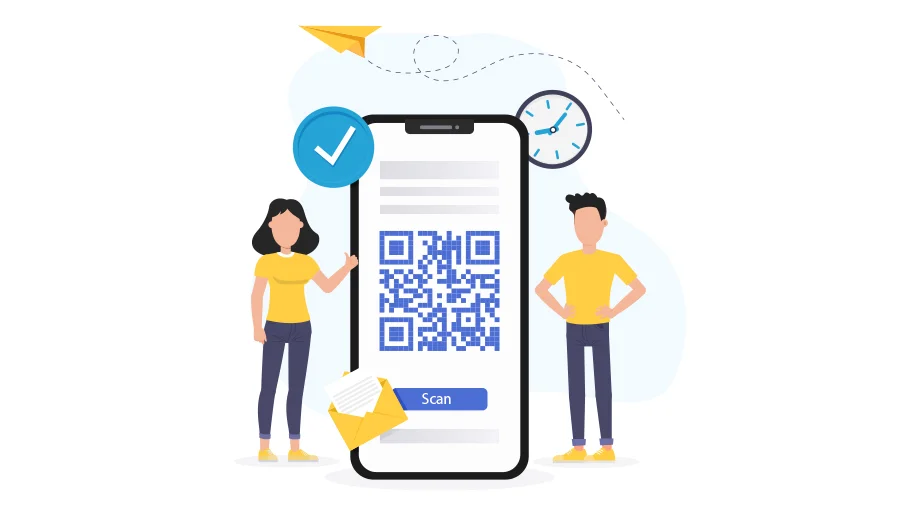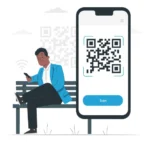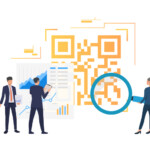Many businesses rely on paper records to track field employees who are involved in inspection, maintenance, and fieldwork. Keeping track of employee hours in the field, tasks they are performing, and equipment they are using can be daunting. The maintenance of job records is labor-intensive and complex.
Tracking employee tasks and monitoring their progress is crucial to managing a business or organization. With the advent of QR codes, this process has become more efficient and streamlined. QR code employee tracking and monitoring systems are being increasingly used by companies to track employee tasks, attendance, and training records.
A QR code is a two-dimensional barcode that can be scanned using a smartphone or tablet camera. The unique design of QR codes allows them to store a large amount of data, such as text, URLs, and even images. This makes them ideal for tracking and monitoring tasks and employees.
Using QR codes for task tracking enables managers to keep track of employee progress and identify areas that may require attention. Additionally, QR codes can be used to monitor employee attendance by scanning a unique employee barcode upon arrival and departure.
QR codes can also be used to track employee training records. Employees can scan a QR code on their training certificate, directing them to a digital record of their training history. This can help managers ensure that employees are up-to-date with required training and certifications.
One of the most significant benefits of using QR codes for employee and task tracking is that they are easily trackable. Managers can access real-time data on employee progress and make data-driven decisions accordingly. Additionally, using QR codes for inventory management can help streamline the process of tracking stock levels and reduce errors.
Improving employee time, task, and equipment usage tracking can not only reduce operational costs but also help in improving operational efficiency. Using QR codes in combination with Geofencing is a great tool to monitor and verify field operations, digitize maintenance data, reduce risks, and bring down costs.
In this blog post, we will explore the various ways in which QR codes can be used for employee and task tracking.
We will cover topics such as how to use QR codes for attendance tracking, employee training records, and inventory management. We will also discuss the benefits and limitations of using QR codes and provide tips on how to implement a successful QR code tracking system.
Benefits of employee and task tracking
For many businesses, employees are their biggest resources and their equipment is their biggest investment. Tracking employee tasks and monitoring their progress can bring many benefits to a business or organization. Here are some of the key benefits of employee and task tracking:
- Increased productivity: Tracking employee tasks and progress can help identify areas where employees may need additional support or resources to complete their work more efficiently. By addressing these areas, productivity can be increased.
- Improved accountability: By monitoring, employees are held accountable for their work and time. This can help ensure that employees are meeting expectations and can help address any performance issues.
- Better resource allocation: With real-time updates on field operations, it can help managers better allocate resources and adjust workloads to ensure that projects are completed on time and within budget.
- Data-driven decision-making: Field operation tracking can provide valuable data that can be used to make informed decisions about resource allocation, project timelines, and employee performance.
- Improved customer service: Managers can ensure that customer needs are being met efficiently and effectively. This can lead to better customer satisfaction and loyalty.
- Automatically generating job and payroll reports: Employee time tracking software can automatically generate job and payroll reports based on the data collected. This can save managers significant time and effort in manually creating these reports and can help ensure that payroll is accurately and efficiently processed.
Overall, employee and task tracking can help organizations operate more efficiently and effectively by improving productivity, accountability, and communication.
How can QR codes help?
QR codes were invented in the mid-90s and were originally used in automobile manufacturing plants to track parts. As the advantages offered by QR inventory tags became apparent, more and more industries began using them.
The codes can contain basic information like links to websites or large volumes of data consisting of over 4,200 alphanumeric characters that are encoded into the patterns. To access the information, a person needs only to scan the QR code.
QR codes are legitimately some of the most convenient pieces of technology out there but businesses don’t quite know how to make QR codes or how to deploy QR codes.
This is where allGeo comes in. We help businesses generate and deploy QR codes for their field operations, and provide a mobile app to scan QR codes to check-in/check-out at a job site, perform tasks and monitor the use of the equipment at the job site.
How can you deploy QR codes?
The simplest way to deploy QR codes is to generate them, print them on various materials (paper, plastic, metal), place them at the job site or equipment, and have employees scan them during normal operations. With every scan, information is recorded, such as:
- Task X was performed using equipment Y at 9 am by Richard in building#3 for 35 min
- Maintenance work was performed on equipment X by John at 4 pm, and one issue was found
- 7 employees were late to jobs this past week
- Tasks were performed on equipment Y in building#3 was used for 22 hours this week
- Richard, Jake, and Roberto worked on key activity Z in building 2 and finished the shift on time
All this information can be available to operations managers from anywhere and at any time if the information is stored in the cloud with every scan that takes place in the field. Businesses can run analytics to look at employee hours, tasks performed and equipment use over time, the number of issues or problems recorded every day, and so on.
The power of QR code & Geofencing
One of the hallmarks of deploying QR codes is the convenience factor. Businesses can get up and running with QR codes very quickly.
Geofences, also known as geo zones, are virtual perimeters around a predefined area of interest, like warehouses, construction sites, or live customer project sites. When combined with real-time GPS information from an employee’s phone when scanning a QR code for instance, it can help track and map each employee’s location via GPS. This helps managers ensure employees are where they need to be and are performing tasks on the right equipment at the assigned times.
Reporting and Payroll
QR codes can be of great help to track day-to-day operations and address issues in real-time but good reporting can help you see the bigger picture over a longer period. Payroll reporting for example can be of great help.
What if you were able to automatically track work hours for each employee so that they would not have to fill out timesheets? This is possible with QR codes & Geofencing. With the allGeo QR code-based time and attendance workflow, businesses can do exactly this.
Supervisors can edit payroll reports and approve them before they go to payroll. Similarly, other types of reports can help in monitoring job performance by measuring operational KPIs for your business.
Tracking and maintaining employees, tasks, and equipment is critical for the operational efficiency of any business. Solutions such as those provided by allGeo help companies to use QR codes to track their employees and tasks quickly and easily. Since employees do not need any extra training, QR codes can be deployed quickly and can be game-changing for the business.
Conclusion
QR codes have revolutionized the way businesses and organizations track employee tasks and monitor their progress. QR code employee tracking and monitoring systems have made it easier for managers to keep track of employee attendance, task progress, and training records. By using QR codes, businesses can streamline their tracking processes, increase productivity, and improve accountability.
Additionally, QR codes can be used for inventory management, which can help reduce errors and make the process more efficient. Furthermore, automated reporting can save managers significant time and effort in generating job and payroll reports, while also providing valuable data-driven insights into employee performance and compensation.
Although there may be some limitations to using QR codes for employee and task tracking, such as the need for reliable technology and training, the benefits of using QR codes far outweigh the potential drawbacks. By implementing a successful QR code tracking system, businesses can operate more efficiently and effectively, while also fostering a more collaborative work environment.
About allGeo
Abaqus, based in Silicon Valley, CA, is a leading provider of cloud-hosted, low-code / low-IT field service automation platform that helps midsize and Enterprise businesses achieve field service excellence. The allGeo platform helps businesses customize and automate their field service workflows to better manage and optimize their operations, field employees & assets.
With allGeo, Field service businesses can significantly reduce payroll and operations costs while improving productivity and accountability. The allGeo platform hosts a suite of turnkey apps that can be rapidly deployed in a wide range of industries e.g. Scheduling, Time Clock, Tracking & Monitoring, Mileage, Dispatch, Electronic Visit Verification, Lone Worker Safety, and Field Inspection using QR / mobile forms. Visit www.allgeo.com for more information.


